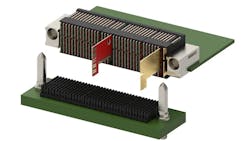What you’ll learn:
- Benefits derived from the VITA 100 standard.
- Top five goals set by the working group for VITA 100.
The VITA 100 standard represents a significant advancement in embedded computing technology. Building on the legacy of VPX that’s incorporated into standards like SOSA and HOST, VITA 100 aims to meet the increasing demands for processing power and data-handling capabilities in modern systems. The VITA 100 working groups consider VITA 100 to be a continuation of VPX but with a leapfrog in technology.
Some of the key values and benefits of the VITA 100 standard include:
Increased density and speed: VITA 100 uses TE Connectivity’s MULTIGIG HD 2 connector (see figure) that doubles the pin density of current VPX connectors, allowing for more connections in the same physical space. The increase in density supports higher data rates, with capabilities of up to 100 Gb/s. This is crucial for applications requiring high-speed data transfer, such as advanced radar systems and high-performance computing.
Enhanced power capacity: As processing power increases, so does the need for power. VITA 100 addresses this by boosting the power capacity of VPX systems to above 500 W. This ensures that systems can handle more demanding applications without compromising performance.
Ruggedness and reliability: The VITA 100 standard is designed to perform reliably in rugged environments. This makes it suitable for military and aerospace applications where systems must withstand harsh conditions.
Enhanced interoperability: One of the significant advantages of VITA 100 is its enhanced interoperability with key components of the architecture. Thus, organizations can upgrade their systems to take advantage of the new standard without needing to replace their entire infrastructure.
Support for advanced protocols: VITA 100 is designed to support higher-speed protocols, including 100G Ethernet per lane and PCIe Gen 6. It future-proofs systems, ensuring they can handle the next generation of data-processing and communication technologies.
The top five goals set by this study group are defined to exceed VPX as follows:
- Speed: 4X the current supported data rates
- Density: 2X the number of pins
- Power: 2X the available power
- Size: 4U form factor added
- Interoperability: VPX compatible and 5X fewer profiles
These projects require a great deal of time from the working group participants. Constructive collaboration is a common element of each working group: Every working group chairperson is challenged with keeping all contributors in unison. Hearing out all inputs, discussion, and comments, and then making a decision takes lots of diplomacy and patience.
All of them are under heavy pressure to produce a document that can be used to start making prototypes critical to proving out the draft standards, adding even more difficulty to the job. They should all be commended for their dedication to the standard's working group efforts.
In summary, the VITA 100 standard offers increased density, speed, power capacity, reliability, and interoperability, making it a valuable advancement for embedded computing systems. Its backward compatibility and support for advanced protocols ensure that it will be a critical component in the evolution of high-performance and rugged computing applications.
About the Author

Jerry Gipper
Executive Director
Jerry is the executive director of VITA where he is responsible for the management of the organization. With over 30 years of experience in the marketing of VITA technologies such as VMEbus, VPX, PMC, and more, he is recognized as an industry authority in embedded board, system, and software technology.

